THE DECATUR TRANSFER HOUSE
H. George Friedman, Jr.
Last updated February 20, 2023 (added Picture 15.1)
Decatur, Illinois has the distinction of having a street corner
which is the intersection of Main Street and Main Street: North-and-South
Main Street, and East-and-West Main Street. Up to 1962, when it was
rebuilt to facilitate traffic on U. S. highway 51, this intersection was
a wide square called Lincoln Square (originally Central Block), and had
a small round building in its center called the Transfer House.
Decatur was an early streetcar electrification.
In 1889, the Citizens' Street Railway (Decatur Street Railroad) became the
Citizens' Electric Street Railway (Decatur Electric Street Railway),
with a plan to electrify its horsecar lines.
Electric streetcar service began on August 28, 1889.
In 1891, the company was reorganized as the City Electric Railway.
This became the Decatur Traction and Electric Company in 1899.
It was sold to the William McKinley interests, which became the Illinois
Traction System (ITS), in 1900. After December 1903, the company
was known as the Decatur Railway and Light Company.
The Transfer House was erected in 1895, replacing a smaller shelter
dating from 1892. The City Electric Railway paid $500 toward the
$2700 building fund subscribed by local merchants and property owners,
and agreed to furnish and maintain the building. As its name implies, it
was used as a central transfer point for all the streetcar lines (and later
the bus lines) in the city.
|
In all the pictures in this article, click on the picture for an
enlargement.
|
| Picture 1. |
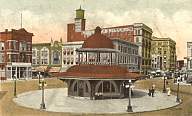
|
The Transfer House, looking to the northeast across Lincoln Square.
At the right we can see a couple of streetcars moving away from the Transfer
House down E. Main Street. Note the ornamental street lights, which were
probably erected about 1910 or slightly earlier. |
| Picture 1.5. |
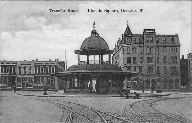
|
We are looking southward from N. Main toward the Transfer House, with
the St. Nicholas Hotel at the far right on the southwest corner of the
square. Note that the ornamental street lights seen in Picture 1 have
not yet been installed. This card is postmarked June 1910. —
Chicago Post Card Co. |
All interurban and city cars in Decatur passed the Transfer House.
The original Illinois Traction System (later Illinois Terminal) interurban
depot was one block east to S. Water Street, then one block south to E.
Wood Street. The interurban line to Springfield was to the west,
starting on W. Main. The lines to Bloomington and Champaign entered
downtown Decatur via N. Main, and left by going north on N. Water Street.
(Later, in 1931, the depot was moved to a point on the belt line, bypassing
downtown Decatur.) City car lines also used the interurban routes to about
the city limits, and there were about four other city car lines not shared
with the interurban cars. A diagram of the tracks at the square,
showing the normal direction of travel, is shown in Figure 1.
Figure 1.
Track at the Transfer House.

| Pictures 2, 2.5, and 3. |

|
These three pictures show the Transfer House, looking north across
Lincoln Square. The upper card is postmarked 1907, the middle 1906,
and the bottom one 1916. On the left in the upper picture is an ITS
interurban car on its way to W. Main Street and the line to Springfield.
On the right is a double truck car, possibly in interurban service, heading
toward E. Main Street. The middle and bottom pictures show interurban cars turning
from N. Main to E. Main Street, heading for the Illinois Traction depot a few
blocks away at the corner of Wood and S. Water Streets. In the bottom
picture, we have a good view of the arched windows in the side of the car.
Note the bell-shaped finial atop the peak of the roof of the upper level. |
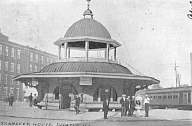
|

|
| Picture 4. |
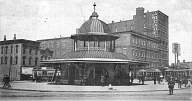
|
A northwest-looking view across Lincoln Square, postmarked 1906.
At the left, an interurban car is working its way from N. Main to W. Main,
bound for Springfield. Three single truck city cars are seen on the right, one of
them following the interurban, the other two bound from N. Main to E. Main.
The interurban and the city car following it are going from our right to our left;
the other two city cars are going toward the right-hand edge of the picture.
The track across the foreground carries the cars from left to right, from W. Main
and S. Main to E. Main. — St. Louis News |
| Picture 4.5. |
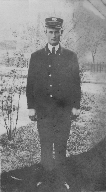
|
Conductor Cleveland Warren, badge number 175, poses in his uniform
in this card postmarked Aug. 22, 1908. The lapels of his double-breasted
coat are marked DR&LC for Decatur Railway and Light Company.
(However, the left-hand buttons are turned at an angle and do not reflect
as the right-hand buttons do.) The card is addressed to his father,
Mr. A. T. Warren. |
| Picture 5. |
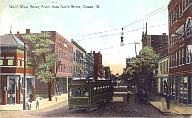
|
This ITS interurban car has just turned onto N. Main Street from
North Street to head south toward Lincoln Square and the Transfer House.
— Deseret News Book Store |
| Pictures 6 and 7. |
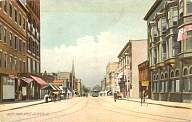
|
Two views looking north on N. Main.
The upper view shows the two tracks on N. Main, and the crossover between them,
looking from the Transfer House, probably before 1915.
The lower view looks northward from the diverging track, probably around 1920.
The track arrangement is unusual, since both branches were used by southbound cars;
all streetcar traffic in these views is toward the camera.
— Rotograph Co. (upper), E. C. Kropp (lower) |

|
| Picture 8. |
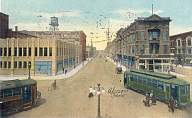
|
The view on this postcard, postmarked 1916, shows two city cars
diverging from N. Main Street. The car at left is headed for W. Main,
while the one at right is taking on passengers and turning into E. Main.
The photographer is facing north, with the Transfer House at his back.
We can make out the car number, 707, on the car at the right. There is
a third streetcar in the distance on N. Main, coming toward the camera.
— Wasson Photo, Walt Cahill Co. |
| Picture 9. |

|
It's a snowy winter day in this view looking northeast. Two streetcars are
stopped at the Transfer House to exchange passengers. A third city car is
coming toward us on the left-hand track on N. Main, and will follow the other
two around the northeast quadrant of Lincoln Square to E. Main St. — A. T. F. Co. |
| Picture 10. |

|
The northeast corner of Lincoln Square had a side street, Merchant St.,
seen in this northward view postmarked 1908. An ITS interurban
car is southbound on the left side of N. Main Street, to turn on the track
across the foreground of this picture onto E. Main, probably on its way
to the ITS depot. |
| Pictures 11 and 11.5. |
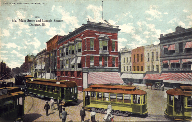
|
The upper picture shows a line of city and ITS interurban cars
on the northeast quadrant of Lincoln Square, turning onto E. Main Street.
The ITS car in the left foreground is turning onto W. Main on its way to
Springfield. This view is postmarked 1908. City car 34, in the
center foreground, is seen in its initial configuration. The lower picture
features sister car 33 at about the same location, signed for the Water Street
line. The 30-37 class cars were built in 1899 by St. Louis Car Co. for
the Decatur Traction and Electric Co. This is a typical turn of the
century wooden car of an ITS city car line. |
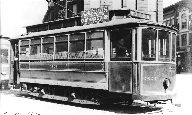
|
| Picture 12. |
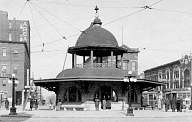
|
Here is a good view of the structure itself. On the far side at
the right, two city cars (the left one a 700-class car) are stopped for
passengers on their way from N. Main to E. Main St. This picture was
probably taken no later than about 1910. — Illinois Power Co. archives,
courtesy of Dale Jenkins |
| Picture 13. |
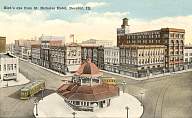
|
This picture was taken from the St. Nicholas Hotel, which is on the southwest
corner of Lincoln Square, looking across the Transfer House to the northeast.
The streetcar near the center, peeking out from behind the Transfer House, is on its
way from North Main to East Main. The car at the left, moving from North Main
to West Main, appears to be an arch roof, double truck streetcar (and not an interurban),
perhaps one of the 1913 St. Louis Car Co. 800-803 class. — E. C. Kropp |
| Picture 13.5. |
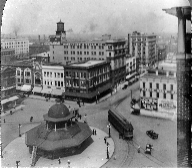
|
This stereo picture was also taken from the St. Nicholas Hotel, looking
across the Transfer House to the northeast. The car rounding the Transfer
House appears to be an interurban. It may be on its way from W. Main to
E. Main, coming from Springfield and heading for the depot. Or it may be
going from S. Main to E. Main, coming from the depot and heading for the line
to Champaign, Urbana, and Danville. — Keystone View Co. |
| Picture 13.7. |

|
This is a postcard view of the interior of the ITS depot at
S. Water and E. Wood Streets. This depot served until 1931, when it was
replaced by a new building along the belt line, bypassing downtown Decatur. |
| Picture 14. |

|
This is a detail from a 1909 panoramic photograph, so there is some curvature
distortion in the picture. (Yes, the interurban car really looks curved, but
it isn't really curved!) This view looks to the southeast, with East Main to
our left, and South Main to the right. The dome of the Transfer House is at the
bottom edge of the picture, near the center. The interurban car is on its way
from South Main to East Main, probably coming from the ITS depot on its way out of town
on the line to Champaign. — International Stereograph Co. (Library of Congress,
Prints and Photographs Division, Panoramic Photographs Collection) |
| Pictures 15 and 15.1. |
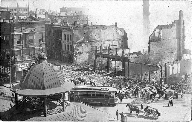
|
Car 706 is maneuvering carefully around the rubble of the disastrous
fire of August 21, 1909 on its way from N. Main to E. Main. The two
photos are not the same, though they seem to have been made by the same
photographer just a few moments apart. (Some of the people in the street
have changed position, and the point of view has shifted slightly to the right.)
The lettering across the second photo dates the pictures to the day after the
fire. The view is to the northeast.
The 706 is one of the steel cars delivered to ITS in January 1908 by the
Danville Car Co. and assigned as needed to various ITS city systems.
The car is barely a year and a half old, and is seen in its original form. |

|
| Picture 15.5. |

|
Here is a closer look at one of the 700-series city cars.
Car 710 is posing at the Wabash depot, as it waits for its next run,
some time around 1915. These cars were originally built without
right-front doors; the doors were added about 1910 when the PAYE (Pay As
You Enter) fare system was introduced.
The motorman and conductor are not identified. |
| Pictures 16, 17, and 18. |
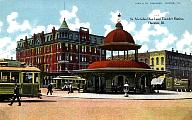
|
Three views looking across Lincoln Square toward the southwest
and the St. Nicholas Hotel. In the foreground of the top card,
postmarked 1909, city car 43, probably a Brill or American Car Co. product
less than ten years old at this time, rounds the turn from N. Main to E.
Main. In the background, another city car rounds the southern part
of the square, probably on its way from W. Main to E. Main. In the middle
picture, taken around 1905, an ITS car, probably just in from Springfield, is moving
from W. Main toward the interurban depot. It will probably go around the
south half of the Transfer House, and exit to E. Main. In the
bottom view, old wooden car 8 leads steel car 704 and another car from N.
Main to E. Main, while an open car heads toward the W. Main Street line.
— Moore & Gibson (middle) |
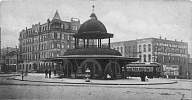
|
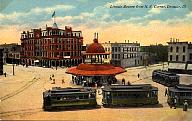
|
| Pictures 18.5 and 18.7. |
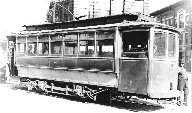
|
Car 8 was one of two cars built in 1906 by American Car Co.
It is seen at the transfer house on its way from N. Main to E. Main,
signed for the Edward line.
Car 43 is posing at the Wabash depot, signed Union Depot, awaiting its next run.
The picture is dated ca. 1915, but it cannot be later than about 1910,
because it lacks a right-front/left-rear door. Such doors were added
about 1910 in the conversion to PAYE fare collection.
|
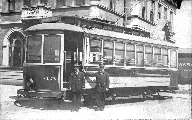
|
| Picture 19. |
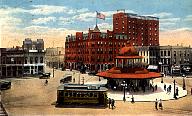
|
This somewhat later view to the southwest, postmarked 1923, shows a new
“skyscraper” built behind the St. Nicholas Hotel.
A few early automobiles share the square with car 42, which is crossing in the
foreground (from our right to left) from N. Main to E. Main Street.
— C. T. American Art |
| Picture 20. |

|
We are looking west from E. Main St.
At the right, we see two city streetcars approaching the Transfer House
from N. Main. To our left, an interurban car is making its way
from S. Main to W. Main, heading for the line to Springfield.
The St. Nicholas Hotel is at the left edge of this picture, with the
Decatur Hotel at the right edge. A sign has been added to the
northeast side of the Transfer House roof. In two lines, it says “BASE
BALL” and “NO GAME”. (Presumably, the second line could be changed,
depending on the baseball schedule.) There is a horse and wagon, and a
bicyclist, but not a single automobile is in view. — Chodat's Book Store |
| Picture 21. |
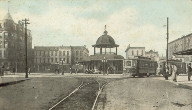
|
This postcard has a similar viewpoint to Picture 20.
Car 40 at our right is leading the way around the northeast quadrant of Lincoln
Square, coming toward the photographer, who is standing in E. Main St.
The St. Nicholas Hotel is at our left. Copies of this card are known to
the author postmarked 1912 and 1914. — Chodat's Book Store |
| Picture 22. |
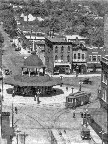
|
This is a view looking westward over the Transfer House.
A streetcar in the foreground has entered E. Main and is coming toward the
photographer, who is in an upper story of a building on the south side of
E. Main Street. Two more streetcars (one barely peeking around the
corner of a building) are following around the northeast quadrant of the
Square from N. Main, and after loading passengers, will follow into E.
Main. Judging by the other vehicles in the street, this picture
probably dates from the 19-teens. — Decatur Tribune, collection
of Dennis DiLullo |
| Picture 23. |
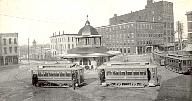
|
This view across Lincoln Square to the northwest shows several of
the 30-37 class cars (37 and 31 in the foreground, and 30 leading the line
on the right) after modification for Pay As You Enter (PAYE) service around
1910. Note the addition of right front doors to both ends of the
double end cars (compare Pictures 11 and 16). |
| Picture 24. |
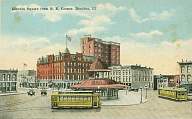
|
Another view toward the southwest and the St. Nicholas Hotel. The
streetcar in the foreground is an older car, going from N. Main to E. Main, from
the viewer's right to left. The car at the right, going from N. Main to W.
Main, is a newer Birney Safety Car. Decatur received its first Birneys in
1919, so this picture probably dates from the early 1920s, before the Birneys had
displaced all of the older streetcars. Note the small number of automobiles,
which also suggests very early 1920s. |
| Picture 25. |
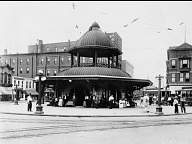
|
This picture is dated 1925, but shows only older types of streetcars
stopped at the Transfer House to exchange passengers. One car is peeking
out around the building to our left, on its way from N. Main to W. Main St.,
and two others are seen at the right heading for E. Main. The nearer track
in the foreground leads from S. Main to E. Main. The view is slightly left
of due north. — Illinois Power Co. archives, courtesy of Dale Jenkins |
| Pictures 26 and 27. |
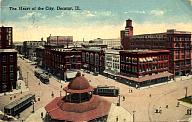
|
Two slightly later views of Lincoln Square and the Transfer
House, looking to the northeast. The upper card is postmarked 1921.
Several single truck city cars are bound from N. Main to E. Main, while
a more modern double truck arch roofed city car (possibly one of the 1913
St. Louis Car Co. 800-803 class) rounds the curve on the west side of the
square. The lower view probably dates from the late 1920s.
There is a considerable crowd around the Transfer House, but the only cars
visible are a two-car ITS interurban train approaching from N. Main to
turn onto E. Main and head for the ITS depot. — E. C. Kropp Co. (upper),
Wait Cahill Co. (lower) |
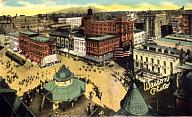
|
| Picture 28. |
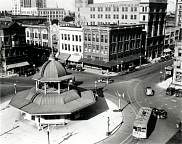
|
Birney safety car 116 rounds the Transfer House on its way from West or South Main
Street to East Main in this 1920s view looking to the northeast. Automobile
traffic has begun to build, and the streetcars must share space with them.
In fact, the right front corner of this streetcar seems almost to be in contact
with the automobile next to it; could this picture have been taken to document
an accident? Note the overhang of the front of the car body from the track.
Motorists often had difficulty estimating where the streetcar would be as it
rounded a curve! — Paul Stringham Collection from Stephen M. Scalzo |
| Picture 29. |
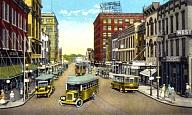
|
Several early buses share E. Main Street with an ITS interurban
on its way to the depot. This view was taken between 1924 and 1931.
— Wait Cahill Co. |
Buses were introduced to Decatur in 1924. City streetcar trackage
had reached 13.5 miles by then, but now began to shrink.
By 1935, only 7.68 miles of track remained in service.
The end of the streetcars came in Decatur on December 14, 1936.
When the square was reduced in 1962 in the name of highway building,
the Transfer House was moved to nearby Central Park. It languished
there, serving as a shopper's resting place and, in season, as Santa's
headquarters, until 1970. It was then renovated for use of the Downtown
Decatur Council as offices and public information center.
| Picture 30. |
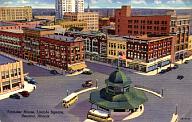
|
After abandonment of the streetcar lines in 1936, city buses continued
to serve the Transfer House. This 1944 postmarked card shows the
reduction of the pavement around the house, and the addition of passenger
loading islands for safety. — Curteich/Decatur News Agency |
| Picture 31. |

|
This picture is taken from a stereocard apparently made by an
amateur photographer. On the back is written "Bus Terminal /
Decatur Ill. / Nov. 12 - 1938". The view is looking north.
The original bell-shaped finial at the top of the roof of the
upper level has been replaced by what appears to be a lightning rod
or a radio antenna. |
| Picture 32. |

|
A winter scene at the Transfer House in 1951. Traffic has been
rationalized to operate counter-clockwise only around the building, as modern
American drivers would expect. |
| Picture 32.5. |
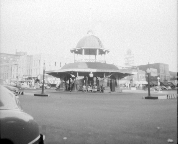
|
This snapshot of the Transfer House is undated, but appears to have
been taken around 1950. |
| Picture 33. |
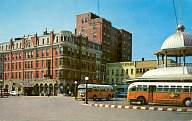
|
Decatur City Lines buses in the “fruit salad” livery exchange passengers at the
Transfer House in this undated picture, probably some time in the 1950s.
The view is toward the southwest and the St. Nicholas Hotel. — Decatur News |
| Pictures 34, 35, and 36. |
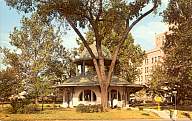
|
The Transfer House after being moved to Central Park.
— Haines & Essick (top); Altrusa Club/Downtown Decatur Council (middle);
R. J. Allen Photo, Collection of Todd Melnick (bottom) |
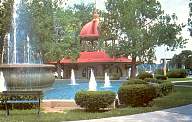
|

|
| Picture 37. |
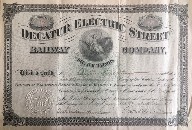
|
Stock certificate number 16 of the Decatur Electric Street Railway Company,
which existed from 1888 to 1891. This certificate was for 2 shares of stock
and was issued July 10, 1889 to Arthur Heurtley, who signed as Secretary of the
company. It is also signed by the company President, Frank E. Snow.
Railroad stocks and bonds, including those of street railroads, are cataloged in
Collectible Stocks and Bonds from
North American Railroads by Terry Cox.
This certificate is catalog number DEC-340-S-30 in that compilation.
— Image and information from the great-grandson of Arthur Heurtley, Allen
Heurtley, whose contribution is gratefully acknowledged. |
The pictures illustrating this article are picture postcards or photos in the
author's collection, except as noted. Publishers' names are given where known.
References:
Thomas R. Bullard, Illinois Rail Transit: A Basic History, privately published, no date, p. 35.
Bill Vandervoort, Chicago Transit & Railfan Web Site, Transit Systems in Illinois,
https://www.chicagorailfan.com/aatil1.html,
accessed April 26, 2020.
Text and captions © 1999, 2000, 2001, 2002, 2003, 2004, 2005, 2007, 2008, 2012, 2013, 2014, 2019, 2020, 2021
H. George Friedman, Jr. All rights reserved. Permission is hereby
given for the QUOTATION of SHORT excerpts, as long as credit is given to H. George Friedman, Jr.
Computer Science Department,
University of Illinois at Urbana-Champaign, Home Page
H. George Friedman, Jr. Home Page











